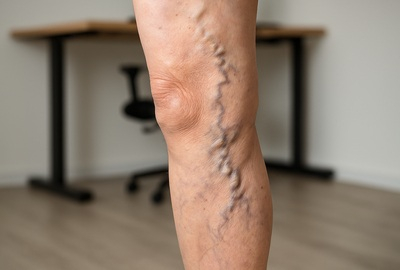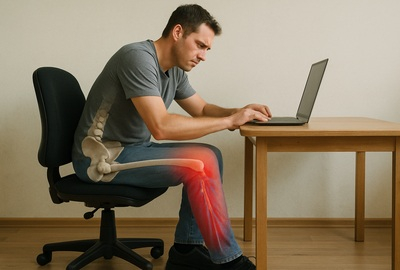- Does Prolonged Sitting Cause Leg Pain?
- 1. How Does Prolonged Sitting Cause Leg Pain?
- 2. Leg Pain from Sitting for Long Periods: What to Watch Out For
- 3. The Link Between Prolonged Sitting, Blood Vessels, and Heart Disease
- 4. Can a Sedentary Lifestyle Lead to Pulmonary Embolism?
- 5. Understanding Health Conditions Tied to Deep Vein Thrombosis and Leg Pain
- 6. Daily Habits to Prevent Leg Pain from Sitting Too Long
- 7. Exercises That Support Lower Leg Health and Improve Circulation
- 8. Ergonomic Solutions That Help You Avoid Blood Clots and Leg Pain
- Conclusion
Does Prolonged Sitting Cause Leg Pain? Find Out Here
How many hours a day do you spend sitting? At a desk, behind the wheel, in front of a computer screen or television? You’re not alone. The average adult spends more than half their day sitting—whether at work, home, or commuting. But what many don’t realise is just how dangerous too much sitting can be, especially when it leads to leg pain and more serious health conditions like blood clots, deep vein thrombosis, and even cardiovascular disease.
In this article, we’ll explore what sitting for long periods does to your legs, your veins, your muscles, and your long-term health. You’ll also get practical tips on how to reduce the risk—without overhauling your entire lifestyle.
1. How Does Prolonged Sitting Cause Leg Pain?
The short answer is yes—prolonged sitting can cause leg pain. When you sit for extended periods, blood flow slows dramatically. The veins in your legs work harder to keep blood moving efficiently back to the heart. Without movement, this process gets sluggish, causing pain, muscle stiffness, and swelling in the lower leg.
Lack of physical activity weakens the gluteal muscles and shortens the hip flexors, which shifts posture and alignment. The result? Poor circulation, varicose veins, and leg muscles that stop working properly. Over time, prolonged sitting affects the blood vessels, compresses leg veins, and leads to persistent aching or a burning or cramping sensation—especially in the calves.
2. Leg Pain from Sitting for Long Periods: What to Watch Out For
Symptoms often start subtly: a dull ache, tingling, or cramping in the legs after hours at your desk. But leg pain from sitting too long can also include:
- Heaviness or tightness in the lower leg
- Mild swelling after a long day sitting
- Cramping sensations that feel worse at night
- Feeling like you have restless legs when trying to sleep
- Sharp, shooting pain after standing up
These aren’t just uncomfortable—they’re warning signs that your sedentary lifestyle is catching up to your body.
In more extreme cases, some people may experience a large leg due to fluid retention or injury that goes unnoticed when seated for hours. If your leg appears swollen or discolored, it’s critical to speak to a doctor—this could be a sign of something more serious like a clot or venous insufficiency.
3. The Link Between Prolonged Sitting, Blood Vessels, and Heart Disease
Research suggests a direct link between sedentary behavior and cardiovascular disease. Inactivity slows circulation, raising blood pressure, increased insulin resistance, and reducing the ability of the blood vessels to respond to stress.
A sedentary time lifestyle is also a predictor for heart disease, with some studies tying prolonged sitting time to elevated risks of heart attack, stroke, and early death. Even if you work out regularly, the negative effects of extended periods of sitting aren’t fully reversed unless you limit your overall day sitting hours.
Extended time sitting, whether at work or while watching television, has also been tied to elevated cancer risks. Some studies highlight a connection between prolonged inactivity and certain types of cancer—including colon cancers—due to systemic inflammation and impaired digestion.
4. Can a Sedentary Lifestyle Lead to Pulmonary Embolism?
Absolutely—and this is where it gets serious. In rare cases, a blood clot that forms from inactivity (often in the deep veins of the leg) can travel to the lungs, causing a pulmonary embolism. This is a medical emergency and can lead to even death.
Signs to watch for include sudden chest pain, difficulty breathing, or coughing up blood. These symptoms need immediate attention, especially if you’ve had prolonged sitting or prolonged standing with no breaks.
A systematic review of multiple studies has linked extended sedentary behavior with a wide range of chronic health issues. The evidence is strong: the more time you spend immobile, the higher your risk across the board—from heart disease to spider veins.
5. Understanding Health Conditions Tied to Deep Vein Thrombosis and Leg Pain
One of the more dangerous risks of too much sitting is deep vein thrombosis (DVT)—a condition where blood clots form in deep leg veins due to lack of movement. It can present subtly with leg pain, swelling, or burning sensations.
If a clot breaks off and travels to the lungs, it may trigger a pulmonary embolism. People with high body mass index, who smoke, or who have a family history of heart disease are at increased risk. This is why the World Health Organization and other health authorities emphasise reducing physical inactivity for long-term health.
6. Daily Habits to Prevent Leg Pain from Sitting Too Long
You don’t need a total lifestyle overhaul—just small, regular changes to reduce sitting for long periods:
- Stand up every 30–60 minutes
- Go for a short walk at lunch
- Use a reminder to stretch every hour
- Stay hydrated to keep blood circulating
- Avoid poor posture and slouching
- Maintain a healthy body mass index
- Quit smoking if applicable
A few minor shifts in your day can dramatically reduce the chances of causing pain, venous insufficiency, or more major complications like DVT.
In some setups, using a smaller version of your main workstation—like a compact standing platform or mobile laptop riser—can help reduce your sitting time at home or while traveling. These lightweight options keep you flexible and moving, without compromising productivity.
7. Exercises That Support Lower Leg Health and Improve Circulation
Boosting blood flow through movement is critical. Try these quick exercises to counteract the effects of a sedentary lifestyle:
- Ankle rolls and toe taps under the desk
- Calf raises and standing leg stretches
- Gluteal squeezes while sitting
- A walk around the block during phone calls
Adding 10–15 minutes of regular exercise throughout the day can keep your muscles flexible and your legs pain-free.
In chronic cases or during recovery from a muscle injury, physical therapy can be highly effective. A licensed therapist can assess gait, posture, and muscle imbalances to restore proper function and relieve long-standing leg pain from poor circulation or inactivity.
8. Ergonomic Solutions That Help You Avoid Blood Clots and Leg Pain
Modern work setups are a big part of the problem—but also the solution. Consider:
- Investing in a standing desk to alternate posture
- Using a footrest for better blood flow
- Positioning your computer screen to support neck and back alignment
- Sitting with knees level to hips to avoid pressure on lower leg veins
Office ergonomics matter more than most people realise. When adjusted correctly, they reduce strain, improve circulation, and keep blood moving efficiently—preventing long-term damage from too much sitting.
Conclusion: Don’t Sit This One Out
Does prolonged sitting cause leg pain? Without a doubt. But it also does more than that—it sets the stage for health conditions that can be deadly. From varicose veins to deep vein thrombosis, cardiovascular disease, and pulmonary embolism, the risks are real.
Luckily, the solution isn’t complicated. Break up your sedentary behavior with a healthy lifestyle that includes movement, smarter posture, and regular checks on your sitting habits. If you experience chronic leg pain, don’t brush it off—it could be your body’s way of sounding the alarm.
Now’s the time to move. Your legs, your heart, and your future self will thank you.


 Buy Now, Pay Later
Buy Now, Pay Later Verified Rating
Verified Rating 




